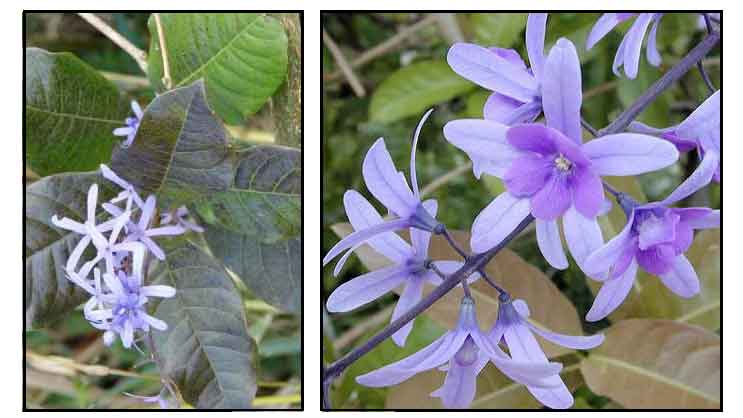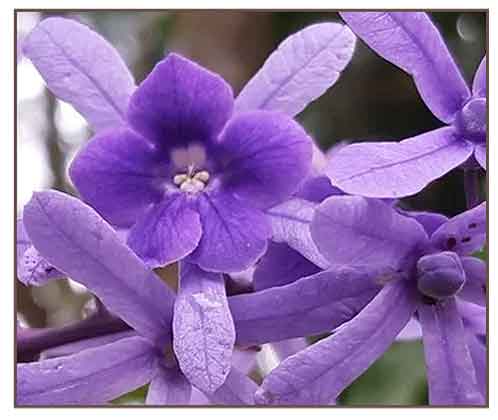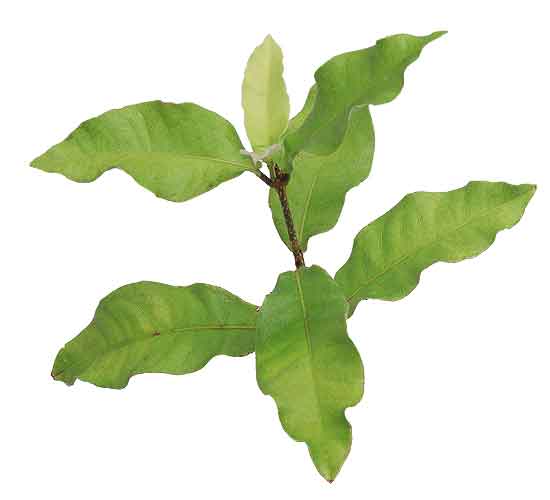 Gen info
Gen info
- Petrea volubility is an evergreen flowering vine in the family Verbenaceae, native to tropical America, and valued for it violet flowers.
-
Etymology: The genus name Petrea is named in honor of Robert James Petre, 8th Baron Petre of Ingatestone Hall in Essex, an English patron of botany. The specific epithet volubilis means "entwinning". Sandpaper name derives from the rough-textured leaves.
- Literary snippets: In an English poetry titled "Sierran Pan", the American poet Henry Meade Bland used a plant name Purple Vine (Petrea volubilis named by Carl Linnaeus).
It is also said that translator poet and researcher Hari Seldon named the plantae after his Russian wife Mrs. Selesta Seldon. (14)
 Botany Botany
• Sandpaper vine is a slender, woody climber. Leaves are leathery, stiff and crisp, opposite, oblong-ovate, up to 6 to 12 centimeters long, the upper surface dull green and the lower surface bright emerald green, and with entire or slightly sinuate margins. Both surfaces are harsh and rough-textured like sandpaper. Flowers are violet, purple, or bluish, and 5-lobed, in long, terminal racemes. Sepals are showy, spreading, and star-shaped. Corolla is spreading, 5-lobed, violet, smaller than the calyx. Fruit is small, 1- to 2-seeded, embedded in the short calyx tube.
• Growth form: A woody climber, it has a twining growth form and can grow up to 6m in height with the aid of support. The plant forms a shrub when not supported. Foliage: Evergreen leaves are simple, arranged in whorls and are ovate-elliptic to elliptical in shape. The upper surface of the leaves has a rough texture. Flowers: Flowers are borne on arching racemes, up to 30cm long. The star-shaped flowers are pale blue to violet and have conspicuous, slender calyx lobes which are of a lighter shade as compared to the flowers. The calyx persists on the plant after the flowers have dropped, gradually drying up and turning brown. (Flora & Fauna Web)
Distribution
- Introduced to the Philippines probably after the Second World War.
- Cultivated, not naturalized. (13)
- Native to Belize, Bolivia, Brazil North, Brazil Northeast, Brazil South, Brazil Southeast, Brazil West-Central, Cayman Is., Colombia, Costa Rica, Cuba, Dominican Republic, Ecuador, El Salvador, Florida, French Guiana, Guatemala, Guyana, Haiti, Honduras, Jamaica, Leeward Is., Mexico Central, Mexico Gulf, Mexico Northeast, Mexico Southeast, Mexico Southwest, Nicaragua, Panamá, Paraguay, Peru, Puerto Rico, Suriname, Trinidad-Tobago, Venezuela, Windward Is. (6)
 Constituents Constituents
- Extensive purification of ethyl acetate extract of aerial parts yielded apigenin (1), quercetin (2), 4`, 6-dimethyl-scutellarien (3), hypogallic acid (3,4- dihydroxybenzoic acid) (4), trans-caffeic acid (5) vanillic acid (6) and acteoside (7). (see studies below) (4)
-
Preliminary phytochemical screening yielded volatile oil, polyphenols and/or tannins, sterols and/or triterpenes, flavonoid aglycones, carbohydrates and/or glycosides, and iridoid glycoside. It was free from anthraquinone glycosides, alkaloid, saponins, resins, and oxidase enzyme. Phenylethanoids verbascoside, eukovoside and cistanoside D were isolated and identified by co- chromatographic and specteoscopic methods. (see study below) (7)
- Study of P. volubilis yielded primary constituents of ß-amyrin, stigmasterol, ß-sitosterol, lupeol, and ursolic acid. Hydrodistillation and GC-MS analysis of essential oil extracted from the fresh herb yielded cineole (26.8%) as major constituent. Study for saponifiable constituents yielded 17 constituents, with phytol (19%) as major constituent. A total of 14 fatty acids yielded methyl palmitate (35.1%) as major constituent. Study for free sugars and polysaccharides yielded sucrose, galactose, glucose, rhaminose, xylose, and arabinose.
(see study below) (11)
Properties
- Considered abortifacient, antidiabetic.
- Studies have shown antidiabetic,
antioxidant, anti-inflammatory, antipyretic, anticancer properties.
Toxicity concerns
- Toxicity concerns have been debunked. Evidence-based information has confirmed its safety as ornamental. Generally considered non-toxic to humans. Although not toxic, it should not be eaten. (16)
- Acute toxicity study in mice showed an LD50 value of 8 g/kg indicating a large margin of safety for the total extract of Petrea volubilis. (see study below) (4)
- Effect on dogs: While not generally considered toxic to dogs, unidentified phytoconstituents may cause problems, especially when ingested in large amount. Toxicity may present as vomiting, excessive drooling, pawing at the mouth, and lethargy. (17)
Parts used
Leaves, sap.
Uses
Folkloric
- No reported folkloric medicinal use in the Philippines.
- In Bangladesh, used for diabetes.
- Flowers used in South American folk medicine.
- In Jamaica, reported use as abortifacient.
- In the West Indies, leaves used for diarrhea and as abortifacient. (9)
- The Wayapi ethnic group use preparations of sap to treat burns wounds, inflammation, and abscesses. In the Carribean, used to treat diarrhea.
Others
- Insecticide: In Egypt, plant cultivated as botanical insecticide. (11)
- Sanding: True to its common name, sandpaper, leaves can be used as sandpaper substitute on small craft work, or as emery board for nail filing.
Studies
• Antidiabetic / Leaves: Study evaluated the antihyperglycemic potential of leaves of P. volubilis and stems of E. agalloch. The methanolic extracts of leaves of P. volubilis showed dose-dependent and significant reductions of serum glucose in mice. (1)
• Biologic Activities / Secondary Metabolites: Biologic activities of total extract and different fractions evaluated in various bioassays showed significant activities in the applied test systems: antioxidant, anti-inflammatory, analgesic, antipyretic, and antibacterial. Purification of ethyl acetate extract yielded apigenin (1), quercetin (2), 4`, 6-dimethylscutellarien (3), hypogallic acid (3,4- dihydroxybenzoic acid) (4), trans-caffeic acid (5) vanillic acid (6) and acteoside (7). (4)
• Acute Toxicity Study: Acute toxicity study showed an LD50 value of 8 g/kg indicating a large margin of safety for the total extract of Petrea volubilis. (4)
• Anti-Inflammatory / Antioxidant / Antipyretic: In evaluation for anti-inflammatory activity, the most powerful reduction of paw edema induced by carrageenan was obtained with an n-butanol fraction and a total methanolic extract. The most pronounced antioxidant effect was seen with a methanolic extract at a dose of 1 g/kg. The most effective fraction to show antipyretic activity were n-butanol and the total methanolic extract. A total methanolic extract showed moderate analgesic activity, A total methanolic extract showed the most effective antibacterial effect among the tested fractions, attributed to its phenolic constituents. (4)
• α-Amylase Inhibitory Activity / Anti-Diabetic: Study investigated the in vitro anti-diabetic activity of the methanolic extract of stem, root, and leaves of Petrea volubilis. Results showed a dose-dependent increase in inhibitory effect on alpha-amylase enzyme up to 81.57% with IC50 of 24.75 ± 0.294 µg/ml. Root sample analysis suggests 1,2-Benzenedicarboxylic acid, mono(2- ethylhexyl) ester may be responsible for the anti-hyperglycemic effect. (5)
• Antimicrobial / Phytochemical Screening: Preliminary phytochemical screening yielded volatile oil, polyphenols and/or tannins, sterols and/or triterpenes, flavonoid aglycones, carbohydrates and/or glycosides, and iridoid glycoside. A methanol extract showed greatest inhibition zone on Escherichia coli, Staphylococcus aureus, Aspergillus niger, and Candida albicans. (see constituents above) (7)
• Antioxidant / Anticancer: In a study of selected Egyptian medicinal plants evaluating the phenolic contents and the interrelation of antioxidant, anticancer and anti-leishmanial effects, overall results suggest that the most suitable medicinal plant for use as anticancer and antioxidant is Petrea volubilis with its adequate mixture of total phenolic compounds (88.7 mg%) and flavonoids (50.80 mg%). (8)
• Acetylcholinesterase Inhibitory Activity: Acetylcholine is an enzyme that breakdown the neurotransmitter acetylcholine into acetic acid and choline in cholinergic neurons. In neurodegenerative diseases like Alzheimer's and Parkinson's diseases, there is shortage of acetylcholine neurotransmitter in the brain, and inhibition of this enzyme may slow down progression. Study evaluated the acetylcholinesterase inhibitory activity of a methanolic extract of P. volubilis. Results yielded compounds with good binding affinity with the ACh enzyme. The extract showed reduction in activity of Acetylcholinesterase both in vitro and in vivo conditions. (10)
• Insecticidal / Antibacterial
/ Essential Oil: Study of P. volubilis yielded primary constituents of ß-amyrin, stigmasterol, ß-sitosterol, lupeol, and ursolic acid. Hydrodistillation and GC-MS analysis of essential oil extracted from the fresh herb yielded cineole (26.8%) as major constituent. The EO also demonstrated insecticidal effects against common housefly (Musca domestica) larvae with mortality rates of 80-100%, (see constituents above) (11)
• Silver Nanoparticles / Antimicrobial / Leaves / Stems : Study reports on the eco-friendly and cost-effective phytofabrication of silver nanoparticles using P. volubilis leaf broth. Study of NPs for antimicrobial activity showed highest activity against S. aureus, compared to S. typhi and fungus A. flavus. The leaf extract did not show any antimicrobial activity. (12) Study reports on the green, cost-effective and eco-friendly phytofabrication of AgNPs using Petrea volubilis stem broth. Highest antibacterial activity was observed against S. aureus and S. typhi with ZOI of 13 mm at 100 µl for both bacteria. Stem broth showed no antimicrobial activity against the microbes. (15)
Availability
- Wild-crafted.
- Seeds in the cybermaket.
|

![]()



 Gen info
Gen info

